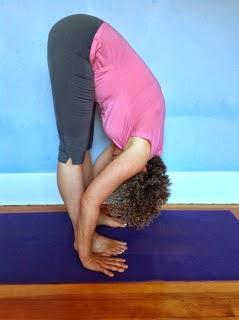 We are often asked by someone if they should avoid certain movements in the joints when doing yoga poses, especially if that person has something going on a particular area. Perhaps the most common area that I get asked about is the movements of the spine (see All About the Spine: Anatomy and Movements for info on spinal movements) These include forward bending (known technically as flexion of the spine), back bending, (known technically as extension of the spine), twisting (known as rotation of the spine), and side-bending (often referred to as lateral side-bending of the spine). There are, of course, possible combinations of these movements in complex everyday activities, such as reaching into the back corner of a deep car trunk to grab a bag of groceries, which includes forward bending, twisting and a bit of side bending, and in real life we rarely do a single spinal movement at one time. But, in general, if there is a particular movement you shouldn't be doing on its own, you should not do it combined with other movements.
We are often asked by someone if they should avoid certain movements in the joints when doing yoga poses, especially if that person has something going on a particular area. Perhaps the most common area that I get asked about is the movements of the spine (see All About the Spine: Anatomy and Movements for info on spinal movements) These include forward bending (known technically as flexion of the spine), back bending, (known technically as extension of the spine), twisting (known as rotation of the spine), and side-bending (often referred to as lateral side-bending of the spine). There are, of course, possible combinations of these movements in complex everyday activities, such as reaching into the back corner of a deep car trunk to grab a bag of groceries, which includes forward bending, twisting and a bit of side bending, and in real life we rarely do a single spinal movement at one time. But, in general, if there is a particular movement you shouldn't be doing on its own, you should not do it combined with other movements.For now, I’d like to keep it simple and address each one of those basic spinal movements over the coming weeks. Today, let’s take a look at those who should avoid forward bending of the spine, as encountered in yoga poses where you bring the front of your torso toward your legs, such as Child’s pose (Balasana), Standing Forward Bend (Uttanasana), Seated Straight Legged Forward Bend (Paschimottanasana), and many others. Forward bending of the spine includes bending from any point in your spine, from your neck all the way to the top of your pelvis. (You can also forward bend strictly from the hip joints, a movement I’m not addressing today.) So who needs to avoid the forward bending spinal movement?
Always Avoid For:
- Osteoporosis of the thoracic (rib cage area) spine
- Herniated discs anywhere along the spine (most commonly at the cervical or neck area of the spine and the lumbar or lower back area of the spine)
- Low back pain that is worsened by forward bending of the spine
- Acute strain of the lower back if you notice pain with forward bending
- A history of degenerative discs in the spaces between the lowest spinal bones, the vertebrae, if you notice pain with forward bending
- Spinal stenosis, if you have been instructed by the doctor to minimize forward bends
- 2nd and 3rd trimester of pregnancy, if you notice pain with forward bending
- Abdominal hernias or abdominal wall separation if increased bulging in those areas is created by forward bending
- Hamstring tendonitis, if you notice any pain in your hamstring muscles created by this movement

